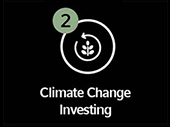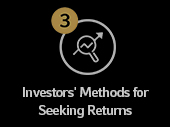10x10, Part 2: Asset owner and manager perspectives on climate change investing
In the third quarter of 2021, Russell Investments held its annual Partner Innovation Lab, a roundtable event where large asset owners from various geographies brainstorm their greatest concerns and areas of interest. We asked Cerulli Associates to interview participating organizations, as well as some of our asset management partners, to extract individual perspectives on topics discussed at the event.* The result was a three-part series of insights.
The following is excerpted from the second installment in the series, which covers asset owner and manager perspectives on climate change investing. A summary of the first installment in the series, which focuses on perspectives toward promoting diversity, equity, & inclusion, was published on our blog in October. The full report can be requested here. The third part of this series, which covers investors’ methods for seeking returns, will be published in early 2022.
Climate change investing trends
Compared to asset managers, asset owners were more varied in their adoption of climate metrics in their investment processes, according to participants in the 10x10 report. Several managers have built out proprietary research initiatives, leveraging their size and resources to provide more insights into climate initiatives. Among asset owners, nonprofits have generally made greater strides on the climate front.
|
"Our engagements are about asking meaningful questions, and how to improve it. We often own a sizeable portion of our investments so we can influence things in that way." – asset manager |
|
"[We are] engaging with investment managers to make sure that you are taking proxy and voting into consideration. Are they a) voting our shares, with respect to socially conscious initiatives and b) are they engaging with the companies?" – asset owner |
Investment portfolios are also used to help with organization-wide climate goals. Several asset owners have sought to offset their carbon footprints via their investment portfolios, investing in technologies like carbon recapture. Some have set up separate portfolios to do this. Asset managers have sought to provide these types of investment options for their clients, as well as investing their own corporate funds into various technologies.
Climate focus catalysts
Asset managers told Cerulli that their adoption of sustainable investing capabilities is primarily driven by external client demand. Managers generally believe that clients bear the ultimate responsibility in adopting a climate change investing lens. While asset managers take their own measures, internally, to combat climate change, most have clients that do not consider ESG metrics at all and, as fiduciaries, they must invest in a way that is in line with their clients’ objectives.
For asset owners, on the other hand, internal values are the key driving force behind their adoption of environmental metric considerations. Sometimes these internal values emerge from the investment office itself, and other times they trickle in from other parts of the organization. In addition, some asset owners are beginning to adopt a climate focus simply because they project that climate change investing is inevitable.
|
"We saw that first being relevant in Europe, then Asia and now the U.S. The idea of investors using assets to sponsor initiatives that they believe in, relating to climate change, this is how I experienced that more over the years. [It] started in Europe a decade ago. Once investors start valuing that, regulation follows." – asset manager |
|
"ESG will be an important issue. It will become common to think about ESG factors for mutual funds in the future. Success in ESG products depends on whether the resolution of social problems using ESG will lead to firms’ business expansion." – asset owner |
Strategic partners and dedicated resources
There are significant challenges when it comes to gathering, interpreting and acting upon data in the climate realm. As such, asset owners often rely on their intermediaries to provide guidance. A nonprofit explained that its investment consultants are charged with helping them implement ESG considerations and opportunities. A corporate plan sponsor explained that it collaborates with its consultant on developing sustainable equity options for its DC plan and creating the right management structure. Another corporate plan sponsor told Cerulli that its consultant plays a pivotal role in collecting and consolidating data.
In response to ESG demand, asset manager participants said they have built functions or assigned dedicated resources to addressing climate investing. Several managers have hired heads of ESG to assist in developing frameworks and ultimately integrating ESG policies broadly. Some asset owners report hiring heads of ESG as well, although this is a bit rarer as the investment offices tend to be limited in size. ESG heads are often charged with leading their firm’s proprietary climate research efforts and, in some cases, heads of ESG were also responsible for promoting their firms’ DEI efforts.
|
"I think they (heads of sustainability and diversity) are essential. It depends on what you want to do—do you want to approach it as an amateur? Or do you want to deliver expertise on these topics?" – asset manager |
|
"ESG was a special case. We really needed to have a specialist in that role ... my ESG person basically put up a grid that is now the standard approach. Before, everyone had their own opinion on it, so there was some initial pushback. I think it’s important to have that sort of expertise." – asset owner |
Climate data
In addition to other challenges, industry participants struggle to find consistent data across the universe of companies. As asset owners and managers continue to streamline their processes, they are likely asking U.S. companies for the same metrics that European companies are required to disclose, providing an avenue through which there could ultimately be some standardization. That standardization issue also extends to the definition of ESG and how that lack of a definition impacts data and reporting.
|
"What’s the definition of ESG? You might get 10 answers from 10 people. Tesla—one vendor has them top quartile and [another] one had them bottom quartile. So where does that shake out?" – asset owner |
|
"We use a third party to measure carbon footprint, things like that. That will be the friction point—what are you measuring? Did you eliminate this amount of carbon, or provide food for this number of people? No one knows right now." – asset manager |
Barriers to adoption
The most oft-cited barrier to implementation is regulatory hurdles, specifically rules surrounding pecuniary factors. U.S. corporate plan sponsors say that they have not integrated climate considerations because they fear going against Department of Labor (DOL) guidance.
Among firms that have not taken steps, one of the primary reasons was that they did not want to exclude potential investment candidates from their selection processes. A nonprofit told Cerulli that energy sectors that contribute to global warming are often necessary and that it did not wish to exclude entire sectors from its investable universe.
A corporate plan sponsor from Japan also told Cerulli that its plan participants are generally not interested in restricting their investment options for the sake of climate initiatives.
Another factor preventing a fully integrated climate stance is the uncertainty in how to look at passively managed assets. A corporate plan sponsor that allocated a large portion of its assets to passively managed strategies told Cerulli that exclusions are one of the only tools it can use for those assets.
|
"ESG was on our project list last year, in terms of developing a policy or implementing specialized investment options, but until we knew where the regulations were going, we couldn’t justify focusing on it." – asset owner |
|
"A lot of our assets are passive, so exclusions are really one of the only tools we have in this area. While we have a mature framework, it’s not aggressive." – asset owner |
The bottom line
A key takeaway from this research is that integrating a climate investing approach is seldom done in isolation. Asset owners tend to partner with asset managers or intermediaries (consultants or OCIOs) when taking their first steps into a broader approach, while asset managers generally begin by responding to ad hoc client requests, with a full-fledged process often involving partnering with a third-party data provider or specialist. Ultimately, this report shows that climate change investing depends on strategic partners.
|
The 10x10 Report 3-part series |
||
|
Coming soon |
||
*Participating institutional investors included the following corporate retirement plan sponsors, in alphabetical order: The Boeing Company, Fujitsu Global, Mazda Motor Corporation, Microsoft, Mitsubishi Electric, Nestlé, Roche and Unilever. It also included the following non-profit investors: The New York Presbyterian Hospital, Robert Wood Johnson Foundation and Thomas Jefferson University. Participating alternative asset managers included: Brevan Howard, Hamilton Lane and Oaktree Capital Management. Participating fixed-income asset managers included: BlueBay Asset Management and Western Asset Management Company. And participating multi-asset-class managers included BlackRock, J.P. Morgan Asset Management, Morgan Stanley, Putnam Investments and Wellington Management.


